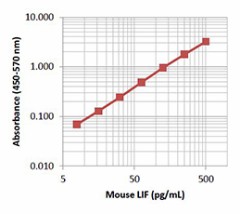- Regulatory Status
- RUO
- Other Names
- Leukemia inhibitory factor, CDF, DIA, HILDA, MLPLI
- Ave. Rating
- Submit a Review
- Product Citations
- publications

| Cat # | Size | Price | Quantity Check Availability | Save | ||
|---|---|---|---|---|---|---|
| 445107 | 1 Pre-coated Plate | £340 | ||||
LIF stands for Leukemia Inhibitory Factor. It belongs to the IL-6 family of cytokines, and is a variably glycosylated, secreted protein with a mass of 38-67kD. The mature form has 180 amino acids, and contains six conserved cysteines which form three intramolecular disulfide bonds. The protein itself forms a four-helix bundle fold. There are two isoforms of mouse LIF formed by alternative splicing that differ by their localization signals. Mouse LIF receptor has one transmembrane and two soluble forms. Mouse LIF shares 92% and 78% amino acid identity with rat LIF and human LIF, respectively.
LIF is a pleiotropic cytokine involved in cellular development, inflammation, immunology, and neoplasia. It often has contradictory effects within different contexts, either stimulating cell proliferation, or inducing differentiation and apoptosis. LIF was originally named for its observed function to promote differentiation of mouse M1 leukemic myeloid cell line into macrophages. With cultured embryonic stem cells, LIF has been an important laboratory tool to help maintain stem cell pluripotency for cell cultures. It is involved in the mechanisms of embryonic implantation, inflammatory disorders such as arthritis, immunomodulation, carcinogenesis, and neoplasia-associated cachexia.
LIF binds to both LIF Rα and gp130 on the cell surface to form a heterotrimeric complex, which initiates cell signalling through the JAK-STAT pathway. LIF can also activate the MAPK, PI3K, and p53 signalling pathways. Soluble forms of both binding partners do exist in circulation, and potentially serve to further regulate LIF action.
BioLegend’s LEGEND MAX™ Mouse LIF ELISA Kit is a Sandwich Enzyme-Linked Immunosorbent Assay (ELISA) with a 96-well strip plate that is pre-coated with a goat polyclonal anti-mouse LIF capture antibody. The Detection Antibody is a biotinylated goat polyclonal anti-mouse LIF antibody. This kit is specifically designed for the accurate quantitation of mouse LIF from cell culture supernatant, serum, and plasma. It is analytically validated with ready-to-use reagents.
Kit Contents
- Kit Contents
-
- Anti-mouse LIF Pre-coated 96-well Strip Microplate
- Mouse LIF Detection Antibody
- Mouse LIF Standard
- Avidin-HRP
- Assay Buffer A
- Wash Buffer (20X)
- Substrate Solution F
- Stop Solution
- Plate Sealers
Product Details
- Verified Reactivity
- Mouse
- Application
-
ELISA
- Sensitivity
- 1.6 pg/mL ± 0.8 pg/mL
- Standard Range
- 7.8 - 500 pg/mL
- Materials Not Included
-
- Microplate reader able to measure absorbance at 450 nm
- Adjustable pipettes to measure volumes ranging from 1 µL to 1,000 µL
- Deionized water
- Wash bottle or automated microplate washer
- Log-Log graph paper or software for data analysis
- Tubes to prepare standard dilutions
- Timer
- Plate Shaker
- Polypropylene vials
Antigen Details
- Biology Area
- Cell Biology, Immunology, Stem Cells
- Molecular Family
- Growth Factors, Cytokines/Chemokines
- Gene ID
- 16878 View all products for this Gene ID
- UniProt
- View information about LIF on UniProt.org
Related FAQs
- In your LEGEND MAX™ ELISA Kits, there is a step that calls for washing the plates before adding sample. What is the purpose of this step?
-
We typically use a stabilizer for pre-coated plates. The additional washing step is designed to remove these components before you start the assay. If you do not perform the washing, the effect on assay performance is negligible.
- I have multiple LEGEND MAX™ ELISA kits that I want to run simultaneously. Can I use the same wash buffer for all the kits?
-
The wash buffer provided in all our LEGEND MAX™ kits is the same and the part numbers on the wash buffer bottles in these kits should be identical. For ELISA MAX™ Deluxe and ELISA MAX™ Standard Sets, we provide a recipe for the wash buffer on each kit’s technical data sheet. This recipe is the same for all ELISA MAX™ sets.
- For some of your ELISA kits, why do my serum samples require dilution with assay buffer?
-
In some cases, dilution with assay buffer is required to minimize the matrix difference between the samples and the standards to achieve better accuracy.
 Login / Register
Login / Register 









Follow Us